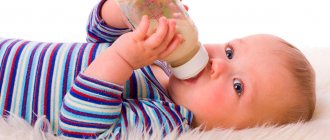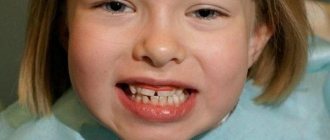Bad teeth in a child: reasons
A child’s baby teeth rot for various reasons.
Some are impossible to influence, others can be easily eliminated by dentists and caring adults. Most often, destruction of the enamel, and subsequently the coronal part of the primary occlusion units, is facilitated by:
- Disorders of intrauterine development of a child. Developmental pathologies are formed due to maternal toxicosis, non-compliance with nutritional recommendations, and the use of potent medications.
- Early birth of the baby. Prematurity of a baby indicates incomplete formation of internal systems - in particular, weak thin enamel of baby teeth.
- Antibacterial therapy administered to a child in the first year of life.
- Poor hygiene. Lack of systematic cleaning after the first tooth erupts, improper care, and inadequate parental control.
- Unbalanced child nutrition. Predominance of flour and sweets in the menu, lack of fermented milk and dairy products, hard fruits and vegetables.
- Reduced immunity. Congenital or due to a lack of vitamins in the diet.
- Diseases of the gastrointestinal tract, dysbacteriosis.
- Diseases of the endocrine system - diabetes mellitus.
- Previous infections - ARVI, chicken pox, scarlet fever.
- Pathogenic microflora entering the baby’s mouth from the outside. If family members have the habit of licking the baby’s spoon or pacifier, or kissing the baby on the lips.
- Poor ecology is a significant external factor that negatively affects the condition of the child’s teeth and general well-being.
- Heredity - parents or grandparents have bad teeth.
- Mechanical injuries, external damage to tooth enamel - cracks, small chips.
Why teeth crumble in adults and how to fix it
Teeth crumble for a variety of reasons - both localized in the oral cavity and related to the entire body. The solution to the problem will be different in each case.
- Poor oral hygiene. If you do not pay enough attention to your teeth, microbial plaque accumulates on them, the bacteria of which produce acids that destroy the hard tissues of the teeth. This is how caries forms and cavities form. To avoid this, brush twice daily with a quality toothpaste such as Colgate® Total® 12 Pure Mint, which fights bacteria for 12 hours for overall oral health.
- Deficiency of vitamins and microelements. Without the supply of “building materials,” bone tissue loses mineral elements and collapses. The food must contain all the substances that strengthen teeth: calcium, phosphorus, fluorides, vitamin D. To maintain the correct ratio of calcium and phosphorus, you need to include in your diet dairy products rich in these elements, eggs, nuts, herbs, beef, and seafood. Vitamin D is also necessary for the absorption of minerals, which is abundant in sardines, herring, salmon, egg yolk, and beef liver.
- Metabolic disease. Improper functioning of the digestive or endocrine system can lead to the fact that even with a sufficient supply of minerals, they are almost not absorbed. In such situations, a thorough examination is required, and then treatment by a specialist.
- Hormonal dysfunctions. Physiological changes in hormonal levels not related to disease lead to disruptions in calcium metabolism. In such situations, the help of a specialized doctor is necessary.
- Bite abnormalities. If the teeth are positioned incorrectly, the chewing load is also distributed incorrectly. Teeth wear out and decay prematurely, and only orthodontic treatment can solve this problem.
- Bad habits that lead to mechanical or thermal injuries to teeth. Tooth enamel becomes covered with small cracks and chips, and then collapses. This is the habit of gnawing hard objects, cracking nuts with teeth and opening bottle caps, and drinking drinks that are too cold or hot.
- Bruxism. Involuntary grinding of teeth, often at night, damaging tooth enamel. The main role in treatment belongs to the neurologist; dental care consists of making soft elastic mouthguards that are worn before bed.
- Hereditary dental lesions. With amelogenesis imperfecta and dentinogenesis, enamel or dentin, respectively, have reduced strength and are easily destroyed. The reason lies in genetic mutations. With regular procedures that strengthen dental tissues, the process can be stopped [1, 2, 3]
At risk for tooth decay are pregnant women, women in menopause, elderly people, children and adults with deficient nutrition.
Pismanik V.S., orthopedic dentist of the highest category, chief physician of the Doctor Dent clinic, St. Petersburg [2]
How to determine if a child has bad baby teeth
A child's rotten front teeth are immediately visible. These are dark or yellow spots of enamel, reddened gums, and damaged edges. But sometimes decay begins on the distant teeth - molars, premolars, and then you need to focus on indirect signs.
The fact that a child is growing bad teeth is indicated by:
- complaints of pain and discomfort - reaction to toothpaste, hot or cold foods;
- unpleasant odor from the baby’s mouth - putrid, pungent;
- change in enamel color - the appearance of dark stripes, yellow or dark spots;
- development of dental diseases - caries, pulpitis.
Any of the listed factors indicates the need for consultation with a pediatric dentist - a full diagnosis and timely treatment.
Why do baby teeth crumble?
In addition to the typical adult causes of tooth decay in children, factors are added that affected the fetus in the mother’s womb. Teeth crumbling in children is often observed due to the fact that the expectant mother during pregnancy:
- had an addiction to alcohol and tobacco;
- experienced a deficiency of vitamins and minerals in the diet;
- suffered severe toxicosis or infectious diseases;
- suffered from anemia, a condition in which there are not enough red blood cells and hemoglobin in the blood;
- experience chronic stress [2].
It will no longer be possible to completely stop the influence of these factors after the birth of a child, and he will be at risk. Therefore, it is very important for the expectant mother to lead a healthy lifestyle, eat properly and nutritiously, follow the schedule of examinations with the attending physician and follow all his recommendations.
Stages of decay of children's milk teeth
A child’s bad teeth almost always mean caries. The disease is distinguished by the type and depth of tissue damage. Dentists highlight:
- Initial and superficial caries is the primary destruction of the enamel, manifested as white spots.
- Visible carious lesions are medium and deep caries. Teeth rot quickly and stains develop into cavities. The child begins to experience pain. An unpleasant odor appears from the mouth.
- Circular caries is the circular destruction of enamel and dentin near the gums. If left untreated, the tooth breaks and rots further to the root.
In particularly advanced situations, damage covers an increasingly larger volume of tissue, leading to serious pain and loss of the milk unit.
Bad teeth in a child: how to treat
Decay of baby teeth can be stopped. Especially if the parents quickly assessed the threat and brought the child to the children's dental clinic. Treatment options are different:
Remineralization of tooth enamel
The doctor will apply a special gel to the baby teeth, which contains minerals to strengthen the teeth. Usually it is calcium, phosphorus, fluorine. The substances will restore the enamel structure at an early stage of destruction, but if the teeth are already rotting, the dentist will select a different treatment.
Sealing
Cleaning out carious cavities and then installing a filling. The preparation method is selected according to the patient’s age. Modern dental clinics treat teeth without a drill - using the ICON method, as well as using classical methods.
Ozonation of teeth
A method of disinfecting destroyed cavities followed by filling, when ozone is used to eliminate pathogenic microflora. The treatment has proven itself to work with children's rotten teeth, but is only suitable for moderate decay.
Laser therapy
The disinfectant effect of a laser beam is an excellent way to disinfect a small cavity and remove bacterial microorganisms in the mouth of a young patient. Suitable for the treatment of moderate caries of primary teeth.
Removal
A radical method of dealing with rotten teeth of a child. Used when it is impossible to carry out therapy and save teeth.
Rodikova Tatyana
When parents are interested in why their child has bad teeth, I first of all ask about nutrition. Almost all children today eat sweets, chips, and drink soda without restrictions. Of course, this negatively affects the teeth. The second common reason is heredity. Congenital diseases and medications are less likely to damage teeth.
How to help your child
The main question is, if a child has bad baby teeth, what should parents do? There are some ways to improve a bad situation. These include the following rules:
- reduce carbohydrate intake if possible;
- do not lick the pacifier or sugar it, especially before bedtime;
- From an early age, accustom your child to brushing his teeth;
- if artificial feeding, use only adaptive formulas after consulting a pediatrician;
- wipe teeth with a swab after feeding;
- Rinse your mouth after every meal as soon as your child is able to do so.
But there is also a main factor that will help cope with bad baby teeth. Of course, this is a visit to the pediatric dentist. The sooner the doctor diagnoses and treats carious teeth, the more likely it is that the baby will grow up healthy and strong. After all, the functioning of the entire child’s body depends on proper digestion. Since dangerous bacteria accumulate in carious cavities, complete tooth destruction cannot be prevented except with the help of an experienced dentist.
Why treat baby teeth?
Rotten baby teeth do not always attract the attention of parents. Especially if the pathological processes are painless and do not bother the child. Adults think that when the bite changes, the bad teeth will disappear by themselves, and instead of rotten teeth, normal molars will grow. Dentists warn about the fallacy of such a misconception.
Rotten milk teeth are:
- damage or destruction of tooth germs - a high risk that the root units will grow sick or not appear at all;
- early loss of primary occlusion units - leads to displacement of existing teeth, the appearance of crowding, and the formation of a pathologically abnormal bite;
- an ugly smile, an unaesthetic appearance - the appearance of complexes due to appearance in young children, decreased contact with peers, uncertainty, isolation;
- deterioration of diction - rotten, breaking teeth interfere with the correct movements of the tongue during speech, leading to a lisp, burr;
- gradual spread of infection - damage not only to the surface of the teeth, but also to the pulp, development of pulpitis, the appearance of an abscess, as well as a tendency to ENT diseases and gastrointestinal diseases.
Treatment of tooth enamel erosion in children
When it comes to damage to baby teeth, remineralization therapy comes first.
The enamel is saturated with fluoride and calcium using special gels and applications. If necessary, the procedures are supplemented by taking medications with appropriate microelements. Damage to permanent teeth also requires remineralizing treatment. In case of deep erosions, restoration is carried out using composite (filling) materials, veneers or crowns.
It is important to eliminate the provoking factor: endocrine pathology, diseases of the gastrointestinal tract.
How to prepare your child for an orthodontic appointment
The initial appointment with an orthodontist takes place without any preparation. The child just needs to brush his teeth and eat beforehand. The latter is desirable, as it will help reduce salivation and facilitate the examination procedure. The child should also be told about the doctor’s specialization. In simple words, explain who this pediatric orthodontist is and what he treats.
An orthodontic examination is a painless procedure. It does not cause fear or discomfort in the baby, but it helps to identify deviations in the development of the dentition as early as possible.
Soldatenkova Alina
Typically, the removal of decayed milk teeth involves the extraction of several units at once. At Azabuka, we recommend performing this procedure under anesthesia or sedation. It is completely safe for the child, and most importantly, it does not leave traumatic, unpleasant memories in the child’s memory.
Other causes of enamel darkening in children
Rotten baby teeth in a child look different in the photo. Usually these are black spots, lumpy enamel, deformed crowns - unpleasant, ugly, even creepy. But an unaesthetic appearance does not always indicate rotting. Sometimes the reasons lie in other diagnoses or pathologies:
- black plaque;
- enamel hypoplasia;
- abnormalities in tooth shape.
Black plaque - stains on baby teeth
Dark spots on teeth are not always tooth decay. It could also be:
- Priestley's plaque - appears due to the increased activity of certain bacteria that secrete a black pigment. The defect is aesthetic, but dentists advise cleaning the enamel from plaque, since it can prevent caries or other dental diseases.
- Dark deposits due to taking iron supplements are an aesthetic problem, which professional cleaning helps to cope with.
Dark pigmentation is also caused by dysbiosis, lack of calcium, and taking antibiotics. Plaque is removed using gentle dental cleaning methods, returning the enamel to its natural whiteness.
Enamel hypoplasia and tooth shape abnormalities
Hypoplasia manifests itself as a change in the structure and color of the enamel and is not a carious lesion. Is it congenital or acquired? In the case of systemic hypoplasia, the shape of the dentition units may also be affected. Externally, the pathology manifests itself as:
- an altered line of the tooth edge is a natural deformation, and not due to rotten teeth;
- barrel-shaped crowns, cone-shaped - due to changes in the tooth at the dentin level;
- spots on the tooth surface of different sizes and shades - altered enamel thickness, insufficiently developed tissues.
For isolated manifestations, hypoplasia is not treated. In case of severe defects in baby teeth, the doctor will suggest remineralization and filling of the affected areas.
Symptoms of tooth erosion in children
The severity of symptoms largely depends on the degree of destruction and activity of the process. With a shallow lesion, tissue changes are invisible; a specific yellowish coloration is visualized only in the dentist’s office after drying the surface and/or treating it with iodine.
As the process spreads, round or oval lesions resembling a bowl begin to appear on the surface of the teeth. Initially they are whitish in color, but as they approach dentin they acquire a yellowish or light brown tint.
Subjective complaints arise in the active phase of the process with moderate or deep damage. The child pays attention to the increased sensitivity of the teeth to hot, cold, sour foods, and discomfort when brushing the teeth.
How to protect your child's teeth
Among the main preventive measures for the preservation of teeth in children of any age are:
- Maintaining oral hygiene to prevent plaque formation - timely care, selection of toothbrushes and toothpastes according to age, professional cleaning using gentle methods.
- Good nutrition - creating a varied menu that will include yoghurts, kefir, cheeses, vegetables and fruits.
- Selection of a vitamin complex according to age - independently or after consultation with a pediatrician.
- Timely visits to the dentist - pediatricians recommend coming for scheduled appointments every 4-6 months. This helps to identify caries and enamel destruction at an early stage and save teeth from serious problems.
- Fissure sealing - smoothing the lumpy surfaces of molars and premolars to reduce the risk of caries and rotting of distant units.
Rodikova Tatyana
Parents often have to explain: it doesn’t matter when the child’s bad teeth appeared - at 3 years old or at 7 years old - they need to be treated. Waiting until they fall out on their own is a big risk. Fortunately, in most cases the explanations work and we begin treatment. It's nice to see how a child's face changes when he sees beautiful, even, snow-white teeth in the mirror - instead of rotten and black ones.
It is also worth carefully monitoring the mechanical integrity of the teeth, since any crack or chip is a potential threat to the child’s dental health.
The health of children is the concern of parents. Poor heredity, diseases, premature birth indicate the need for careful monitoring of the condition of teeth - timely prevention and treatment. If everything is done correctly, then the child will not have rotten teeth, but only a joyful and beautiful smile.
What causes baby teeth to deteriorate?
When a baby bursts into a smile and shows off his two lower teeth, it causes tenderness. By the age of 3, a child already has a full set of 20 baby teeth in his mouth.
It’s rare that a mother will miss the moment when her child’s first tooth erupts. This event is so joyful for the family that they rush to tell grandparents, all relatives and friends about the first tooth, like the first steps or the first word.
The first teeth are always a joy
Often, however, you can meet children whose teeth are affected by caries. It happens that it is not one or two holes, but a mouth full of blackened, damaged teeth. Is it worth treating baby teeth? Why do they spoil? What does caries prevention include?
You can often hear the opinion that it is not necessary to treat baby teeth. Why, if they fall out anyway and other, permanent ones grow in their place?
In fact, the condition of baby teeth and the future health of molars are very closely related. The deciduous roots are located around the permanent tooth germ. If you do not get rid of caries, it can lead to inflammation of the periodontal tissues, which, in turn, can damage or destroy the molar tooth germ.
In addition, the presence of healthy baby teeth is necessary for the proper growth and placement of permanent teeth, as well as the normal development of the jaws and muscles. Many mothers believe that if the child is not spoiled with candies and other sweets, then he will not be at risk of caries. However, it's not always the candy that's to blame. There are other actions that are potentially dangerous for the baby’s oral cavity. For example: the bad habit of adults of licking a pacifier before giving it to a child, instead of washing it. Or a “shared” meal using one spoon. A large number of microbes are transmitted, in this case, from an adult to a baby.
The development of caries can also be caused by a bottle of tea, milk, formula or juice, if the baby is used to falling asleep with it. These drinks contain carbohydrates, which create a breeding ground for bacteria in the mouth. Acids released by bacteria begin to destroy teeth.
Clarification: mother's milk does not have a destructive effect. It is sterile, contains antibodies and brings only benefits to the baby.
Prevention of caries should begin not with the eruption of the first tooth, as some parents think, but long before the birth of the baby, in the first months of pregnancy, when the foundation for the development of the dental buds of the intrauterine baby is just being laid. Mom needs to take care of a diet rich in calcium, fluoride, and vitamin D.
Taking care of your baby's healthy teeth begins in the first months of pregnancy
The mother should also take care of a balanced, healthy diet for the baby after birth, while breastfeeding.
If the baby is bottle-fed, the bottle should be used for food and not instead of a pacifier. After the child has eaten, it is advisable to wipe his teeth with clean gauze. This will not always be possible, since the baby often falls asleep immediately after eating. However, this does not mean that everything can be left to chance. If the child is still used to falling asleep with a bottle in his mouth instead of a pacifier, then let it be a bottle with clean water. Later, closer to 2 years, it will be possible to teach your baby to rinse his mouth after eating. Over time, you will need to work hard to develop in your child the good habit of brushing your teeth regularly. It is important and necessary to pay attention to the prevention of baby teeth, as well as consult a doctor in time if treatment is required. And then the child’s smile will only cause joy, not worry! Moscow metro station Zvezdnaya, Danube Avenue, 23











